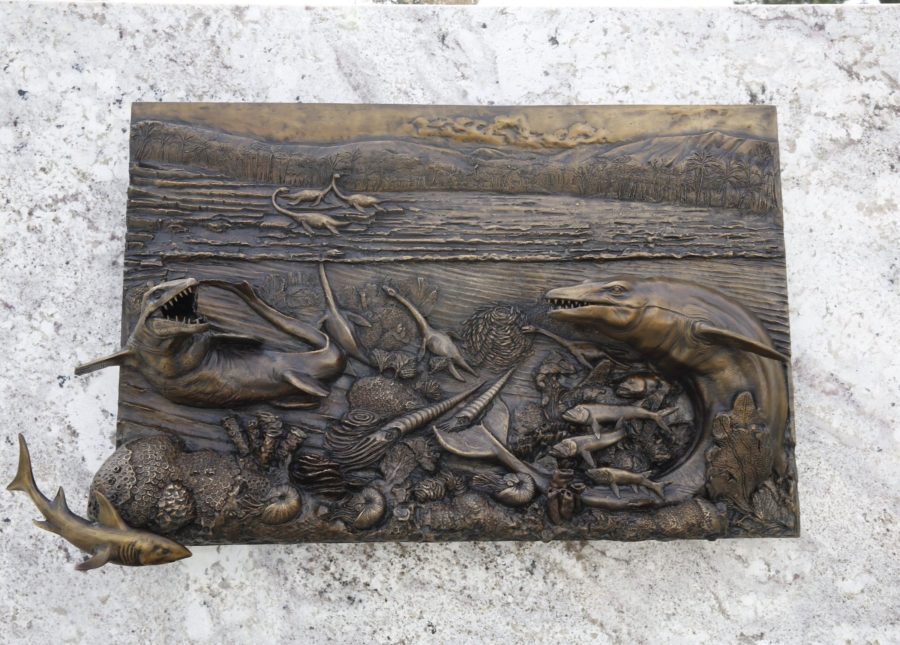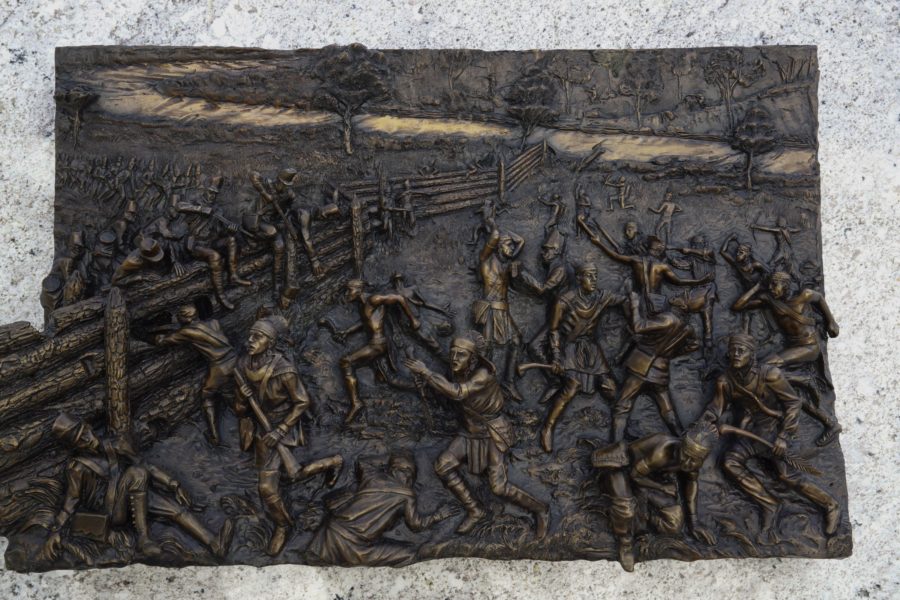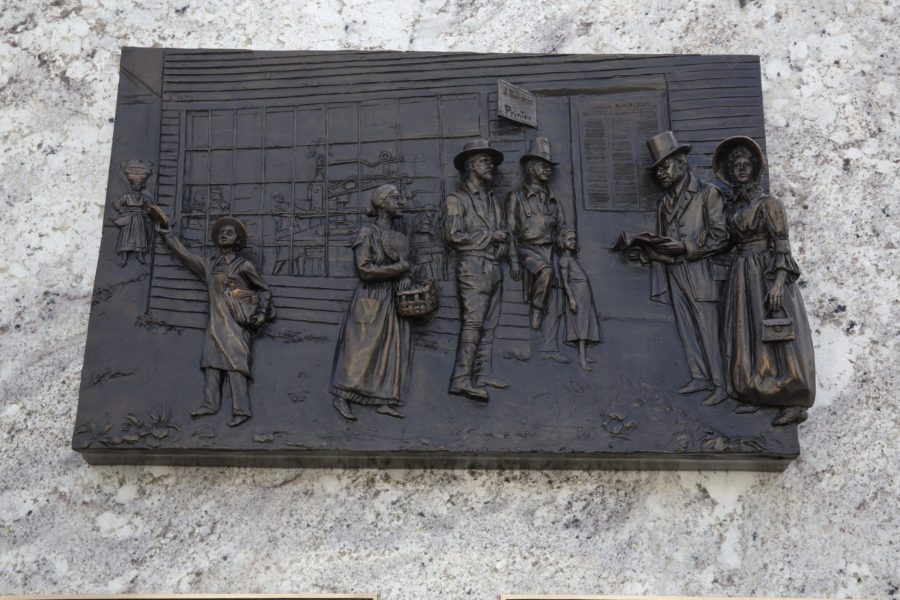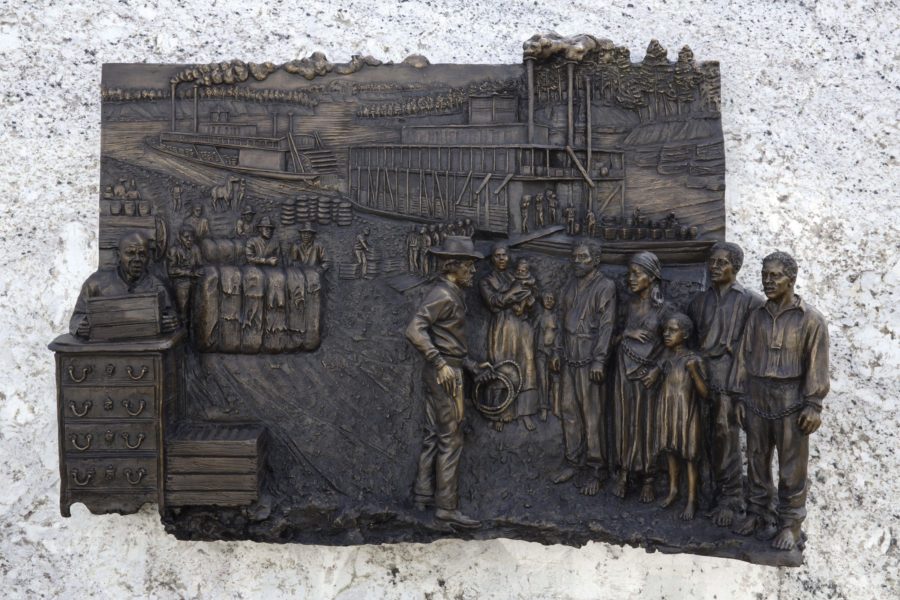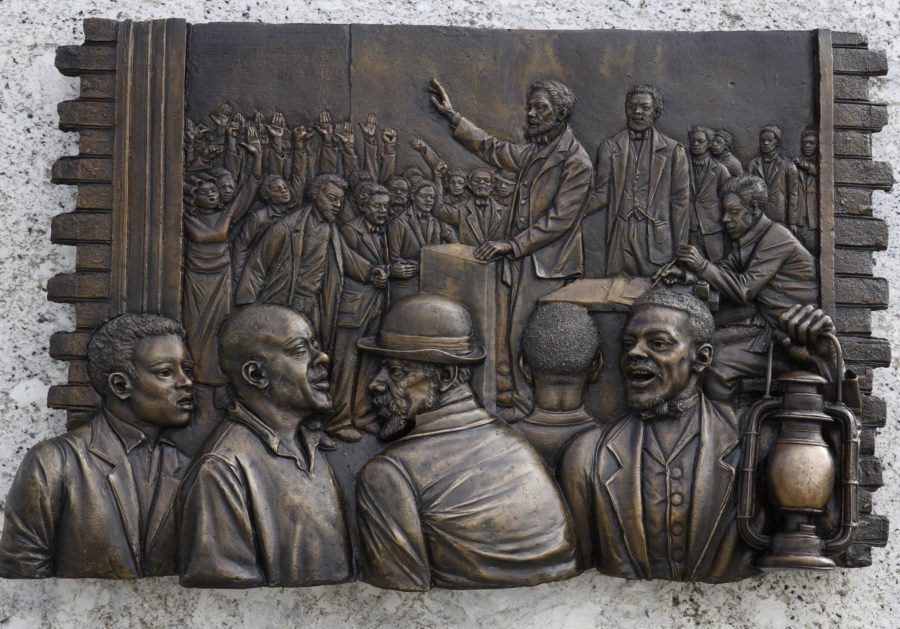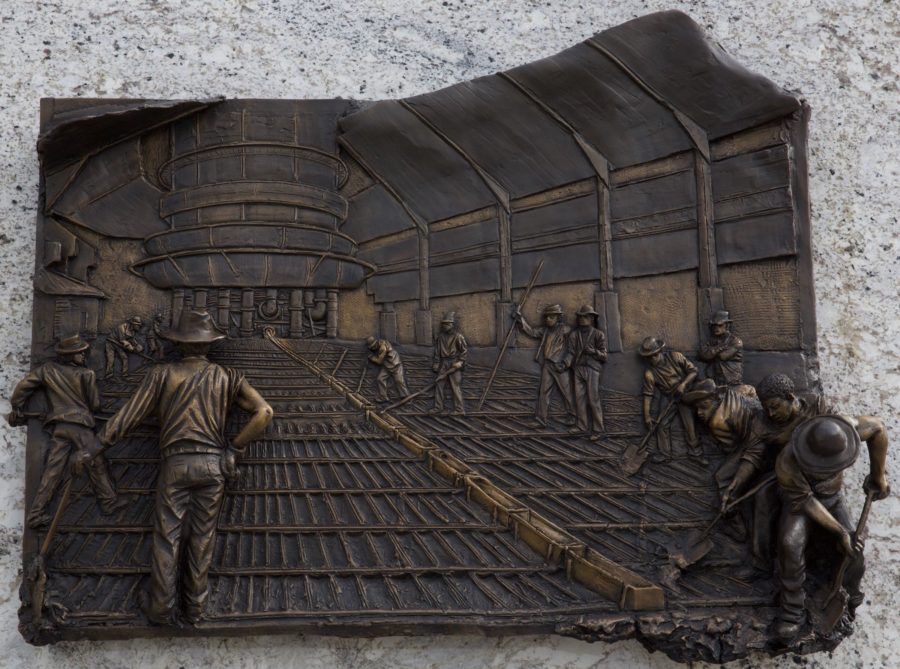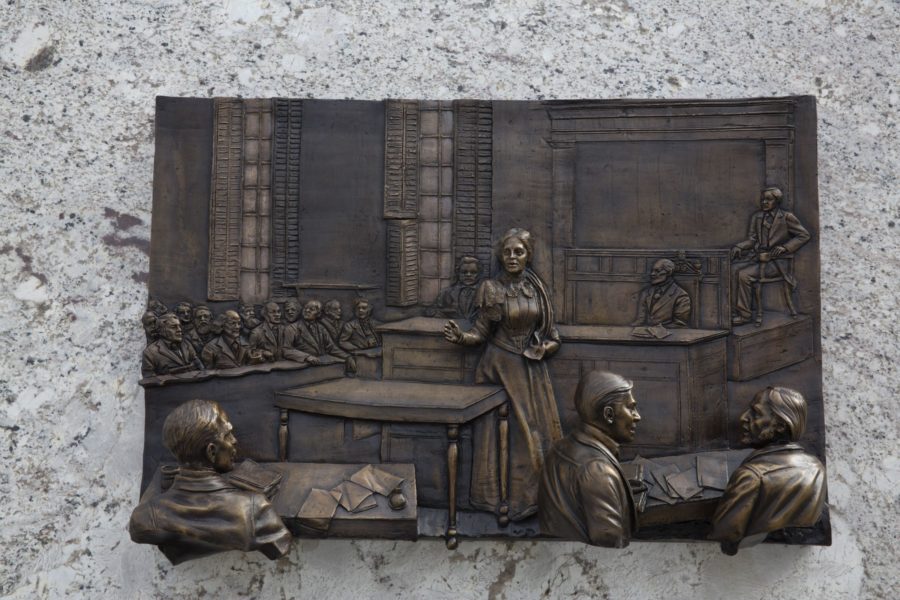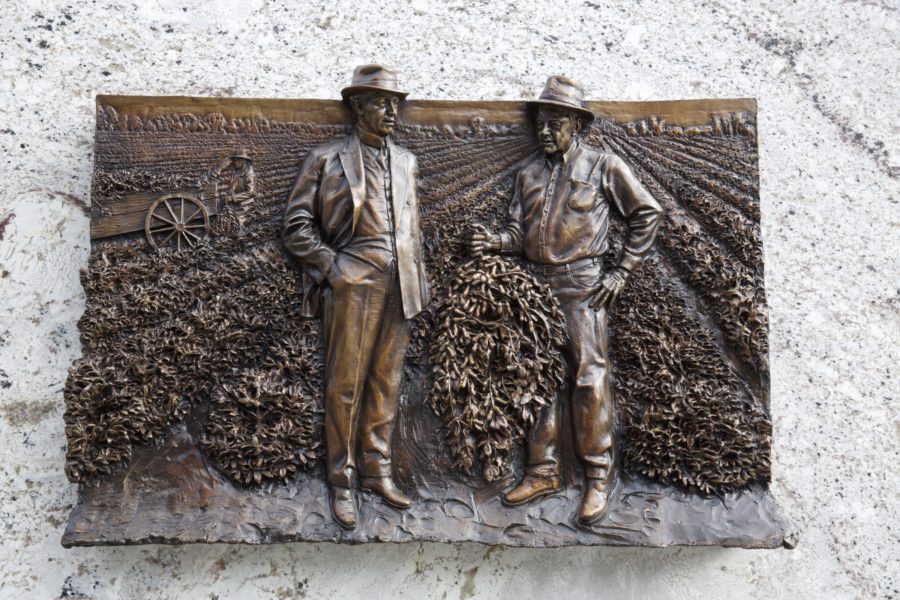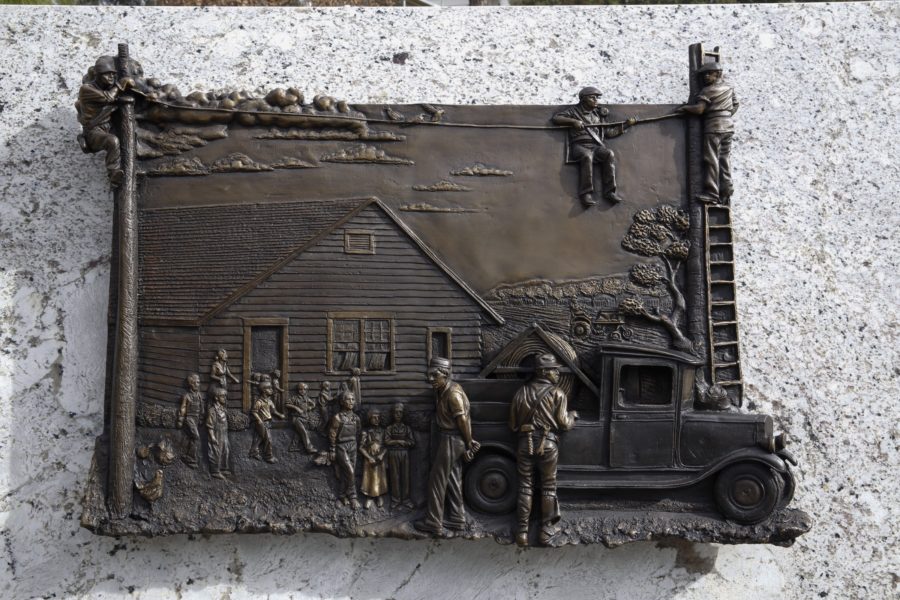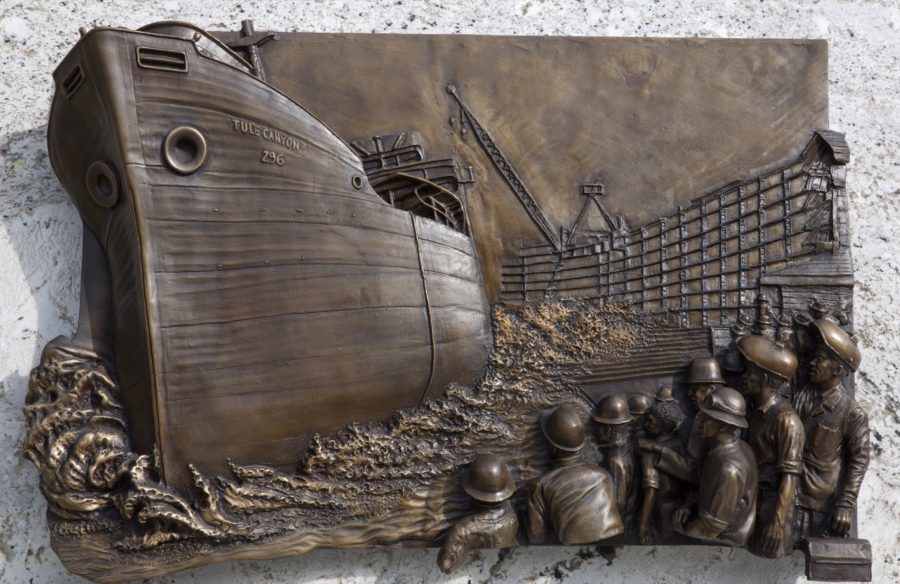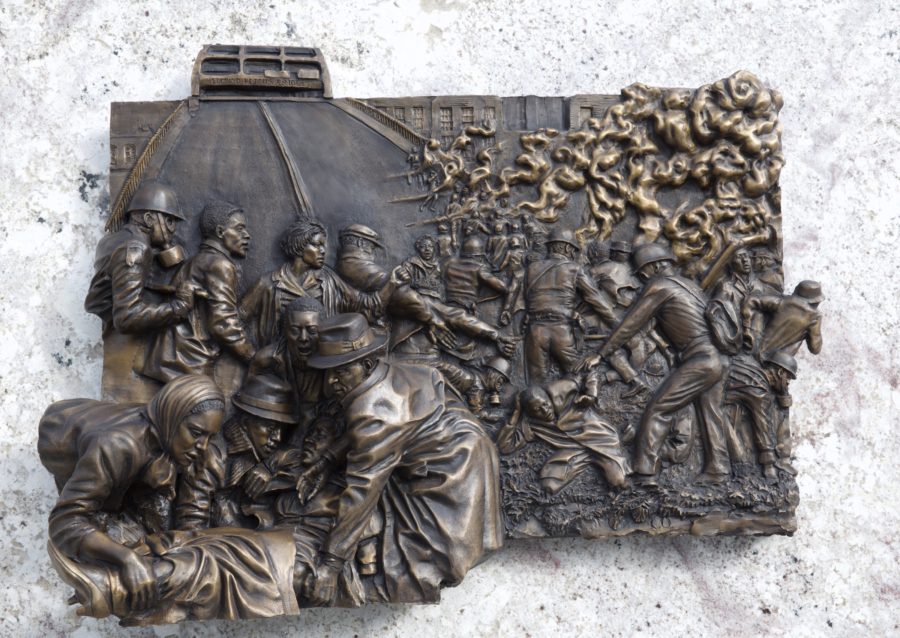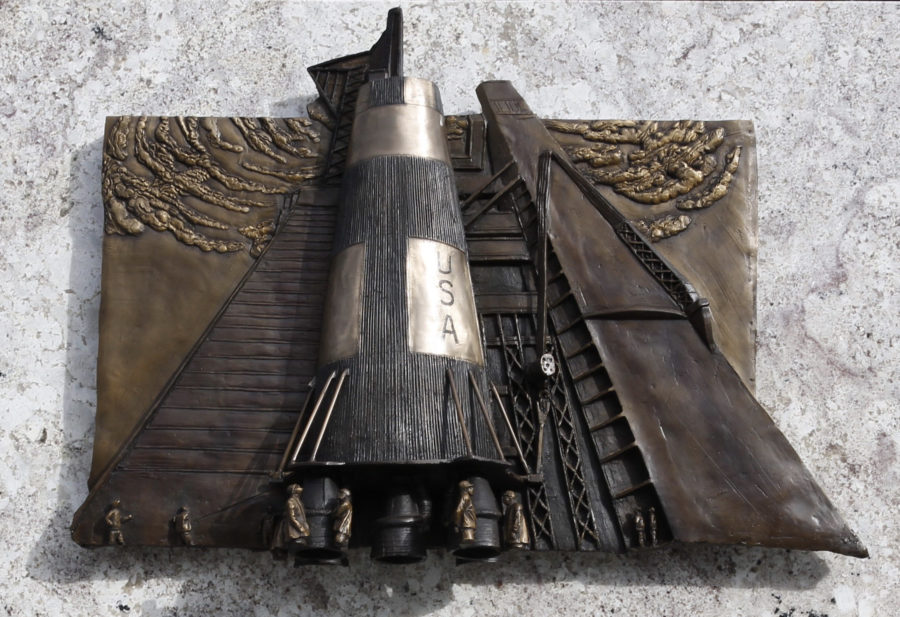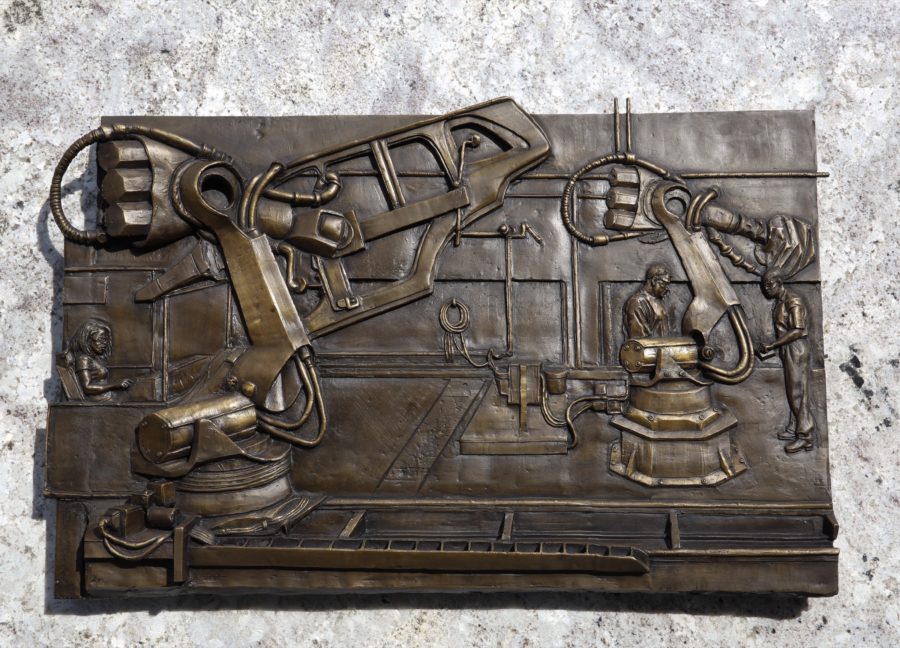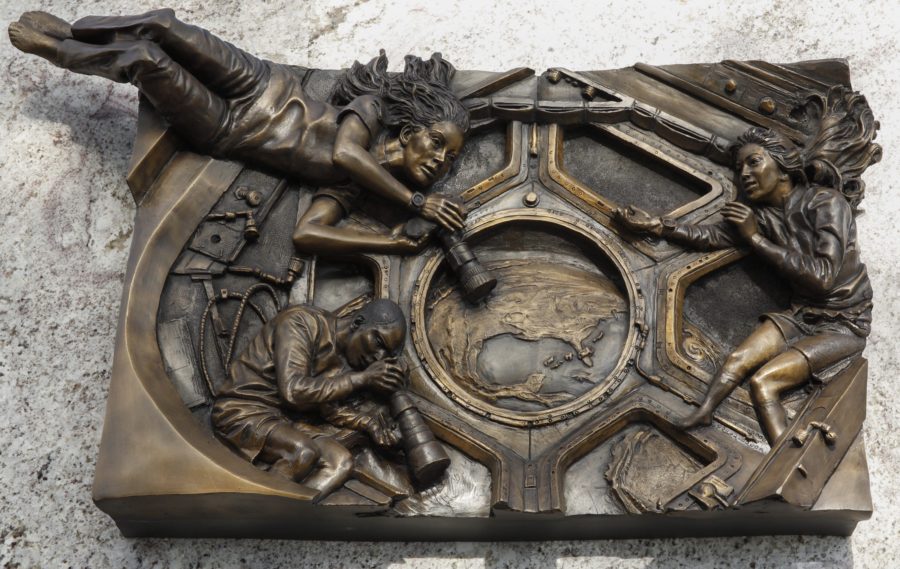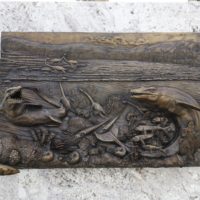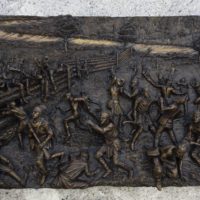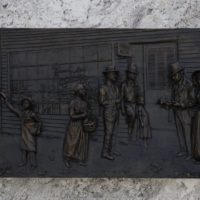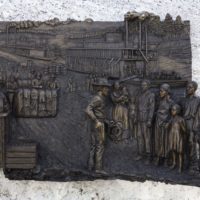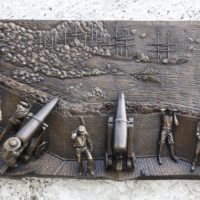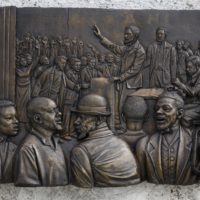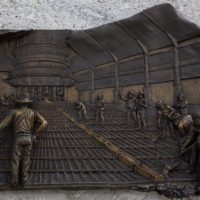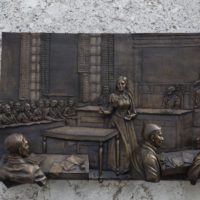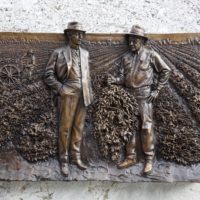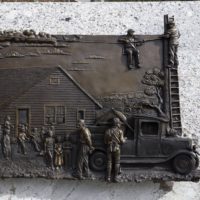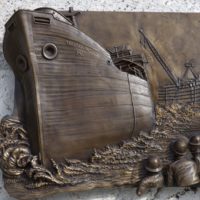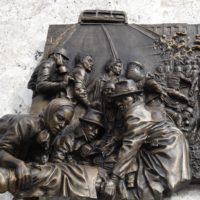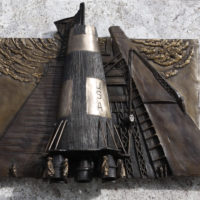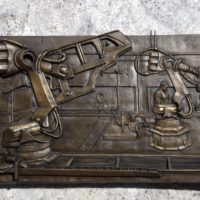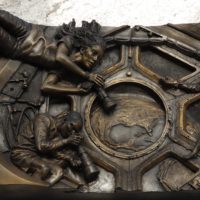Bicentennial Park Relief Murals
Alabama Bicentennial Park commemorates Alabama’s 200th anniversary of statehood. The park’s bronze relief sculptures present sixteen moments from Alabama history, complemented by narratives that provide historical context. Beginning with the land that would become Alabama and tracing its human history to 2019, the images and text reflect a rich, dynamic past filled with challenge, change, and accomplishment. They represent every region of the state and Alabamians of many backgrounds. The hope of those who dedicate Alabama Bicentennial Park in the anniversary year is that generations of Alabamians will see their history reflected in the park, learn from it, and be inspired to make the future strong and bright.
“As we stand in the shadow of our majestic State Capitol and look down historic Dexter Avenue, we must never forget where we’ve come from nor how much progress we’ve made.” – Governor Kay Ivey, Inaugural Address, January 14, 2019
Bicentennial Park in Montgomery, AL was dedicated during the culminating events of the state’s bicentennial commemoration on December 14, 2019. The sixteen panels are installed on either side of the Dexter Avenue approach to the Capitol, atop stands made of Alabama granite.
What follows are the stories and history behind each piece.
Panel 1: Ancient Sea
ANCIENT SEA
Alabama’s history begins in its land, which features some of the greatest geological and biological diversity in North America. The geological effects of compression and erosion created an extraordinary array of natural resources. These natural resources, in turn, influenced how Alabamians interacted with the land, where they settled, and how they made a living. The rich mineral deposits and beautiful vistas of north Alabama resulted from the forming of the Appalachian Mountains. Sedimentation and biologic decay under an ancient sea created fertile prairies in central Alabama and sandy lowlands to the south. Fossils, easily found across lower Alabama, provide evidence of much earlier life.
A 65-foot whale, Basilosaurus cetoides, was a predator in the shallow sea that covered much of Alabama during the late Eocene Epoch of the Cenozoic Era. In 1894, the Smithsonian Institution began collecting Choctaw County specimens that would be assembled for display at the Smithsonian.
Panel 02: Alabama’s First Peoples
ALABAMA’S FIRST PEOPLES
Humans arrived in what is now Alabama near the end of the last Ice Age. Waves of people migrated through the area for centuries before some of them established settlements. Over time, their culture advanced through the development of agriculture and trade. By around 1000 AD, improvements in agriculture supported a sophisticated society spread across much of eastern North America. Artisans created pottery and tools that were functional as well as beautiful, often inspired by nature or their interpretation of the cosmos. Seasonal and harvest celebrations created a rich ceremonial life.
At Moundville, near Tuscaloosa, they built the second-largest mound city in North America. It held influence over towns and villages for hundreds of miles in every direction. By the mid-1500s, war and disease introduced by Europeans devastated the native population.
On a busy summer day in Moundville, ca. 1200, women worked in the cornfields, men returned from a hunt, and travelers arrived with tribute and trade items.
CREEK COUNTRY
Descendants of the mound builders formed community networks that the Europeans would call “tribes.” The most prominent of these in Alabama were the Creeks, a confederation of many towns and families with similar language and traditions. Throughout the 1700s, the Creeks had a vibrant trade with Europeans, exchanging deerskins for manufactured goods. In the Creeks’ matrilineal society, clan affiliation passed through the mother’s line. The bicultural children of Creek women and white men were considered fully Creek by their Indian families. They served as mediators between Creek and white society during a time of rapid cultural and economic change. As the deerskin trade declined, some Creeks established cattle ranches and cotton plantations. Departure from the tradition of communal land ownership created division in Creek society.
“The Lands are not the Property of the Head Warriors, but of the whole Nation in common.”– Emisteseguo, chief of Little Tallassee, to British Officials, 1771
Panel 03: Resistance and War
RESISTANCE AND WAR
In the 1790s and early 1800s, U.S. treaties recognized Creek land ownership, but illegal encroachment by whites began cycles of violence and revenge by both sides. The Creeks disagreed on how to respond. Those who accepted white influence sought to cooperate with the U.S., but others wanted to defend their land and their traditions.
Divisions among the Creeks led to civil war in 1813. The U.S. joined the fight against the traditionalists, known as the Red Sticks. Forces led by Andrew Jackson destroyed Red Stick towns and faced them in a final great battle at Horseshoe Bend on March 27, 1814.
American artillery was ineffective against a massive barricade of pine logs. After a detachment of U.S. soldiers and Indian allies attacked from a second position across the Tallapoosa River, Jackson’s men topped the barricade. More than eight hundred Red Stick warriors died in the hand-to-hand combat that followed, bringing an end to Creek resistance.
ALABAMA FEVER
After Horseshoe Bend, the Creeks were forced to surrender most of their lands in Alabama. Nearly fourteen million acres opened to settlement at a time when Georgia, Carolina, and Virginia farmland was wearing out. As thousands entered the region, many by way of the Federal Road, the enthusiasm for moving west became known as “Alabama Fever.” Wealthy planters acquired large tracts in the Black Belt and the Tennessee Valley. Yeoman farmers settled on small plots, mostly in the hill country. Within another twenty years, the U.S. would forcibly remove nearly all the remaining Indians, opening yet more land.
“Alabama Fever rages here with great violence and has carried off vast numbers of our citizens.” – James Graham, North Carolina, 1817
“Last evening I saw the sun set for the last time, and its light shine upon the treetops, and the land, and the water, that I am never to look upon again.” – Menawa, Creek chief, during removal to Indian Territory, 1836
Panel 04: Alabama Territory
ALABAMA TERRITORY
In 1817, the present-day states of Alabama and Mississippi were both part of one Mississippi Territory. When Congress designated Mississippi as a new state in 1817, it provided that the eastern half of the territory would become the new Territory of Alabama. Alabama’s territorial capital was St. Stephens, a busy frontier town located on the Tombigbee River, north of Mobile. There, the territorial legislature wrote the first laws for Alabama. The territorial governor was William Wyatt Bibb, a doctor and former U.S. senator from Georgia. The population boomed as settlers arrived overland from the north and east. Many planters brought enslaved workers with them, but most of the new settlers were small farmers. Fewer numbers of merchants and professionals, some of them from New England, helped build new towns. The territory’s 1818 census counted nearly 68,000 residents, well above the 60,000 needed to write a constitution and seek statehood.
PATH TO STATEHOOD
In July 1819, forty-four delegates convened in Huntsville to draft a state constitution. They signed the document on August 2 and sent a copy to Congress. While awaiting action by the federal government, Alabama conducted the first elections for state officials in September. The new state legislature met in Huntsville that fall to take up important business, including setting county boundaries, creating roads, and establishing the court system. William Wyatt Bibb, now the state’s first elected governor, made plans for moving the government to Cahawba, a new town located where the Cahawba and Alabama rivers met, near Selma. On December 14, 1819, President James Monroe signed a congressional resolution accepting the new Alabama constitution, thereby formally admitting Alabama as the 22nd state of the United States.
August 5, Huntsville residents had their first opportunity to read the new constitution as copies were circulated from the print shop of John Boardman.
Panel 05: Cotton State
COTTON STATE
Alabama’s rapid growth depended on cotton cultivation. Statehood coincided with improvement of the cotton gin and increased demand for cotton in British and northern factories. Within thirty years. Alabama was producing 23 percent of the nation’s cotton, helping make the U.S. the largest producer in the world. Most Alabama cotton was grown in the Black Belt and the Tennessee Valley.
The vibrant economy supported the creation of churches, colleges, militias, and markets, but very little manufacturing. Commerce relied on the state’s numerous waterways. Steamboats carried cotton downriver for export and returned bearing manufactured goods, passengers, and enslaved laborers.
“Cotton was the sole topic…. At every dock or wharf, we encountered it in huge piles or pyramids of bales, and our decks were soon choked up with it.” – Basil Hall, 1829
At Claiborne, one of the towns visited by Hall, a steamboat unloaded its cargo, including a group of slaves purchased in Mobile and destined for a nearby plantation.
SLAVERY
Slavery was central to Alabama’s development and had lasting effects on its economy, culture, and politics. The labor of enslaved blacks was responsible for much of the state’s early infrastructure, the construction of public and private buildings, and the cotton cultivation that sustained the economy. Nearly one-third of enslaved people lived on large plantations with fifty or more slaves, but many worked on small farms with fewer than five slaves. State law prohibited slaves from owning property or learning to read and write. It also severely restricted the freeing of slaves and the activities of free blacks.
By the start of the Civil War, enslaved blacks accounted for 45 percent of Alabama’s population. Most whites believed the preservation of slavery to be essential to the state’s future.
“Any slave who… furnishes any other slave with any pass or free paper… must receive one hundred lashes on his bare back.” – Code of Alabama, 1952
Panel 06: Secession and Confederacy
SECESSION & CONFEDERACY
For fifteen years before the Civil War, Alabamians took prominent roles in a national debate over the expansion of slavery into the western territories. A series of compromises maintained peace until 1860, when the Republican Party nominated Abraham Lincoln for president on an aggressively anti-expansion platform.
After Lincoln won the election, secessionists clamored for slaveholding states to leave the Union. Delegates to an Alabama convention met in the State Capitol in January 1861 and, by a vote of 61 to 39, decided to secede.
Alabama invited other seceding states to Montgomery, where delegates adopted a constitution for the new Confederate States of America. On February 18, Jefferson Davis was inaugurated president at the Alabama Capitol.
Montgomery was the seat of the Confederate government for three months. From the Winter Building at Court Square, officials telegraphed authorization for the firing on Fort Sumter in Charleston Harbor, the opening salvo to four years of devastating war.
CIVIL WAR
War brought dramatic change for nearly every Alabamian. Three-fourths of white Alabama men of fighting age served in the Confederacy, and around twenty-seven thousand of them died. Many whites in the hill country opposed secession, and some fought for the Union. Eight thousand runaway slaves from Alabama volunteered for the Federal army.
On the home front, white women, their families, and the enslaved kept plantations and farms in operation. Residents struggled under repeated shifts of control by Federal and Confederate forces in north Alabama, where much of the land was devastated. Thousands of slaves leased to the government built Confederate defenses and armaments. Alabama’s young ironmaking industry produced essential munitions for the Confederacy and became the target of Federal campaigns late in the war.
On August 5, 1864, Confederate troops at Fort Morgan mounted a fierce but unsuccessful defense of Mobile Bay against a Federal fleet intent on capturing the last major port under Confederate control.
Panel 07: Emancipation
EMANCIPATION
The end of the Civil War in April 1865 and ratification of the 13th Amendment to the U.S. Constitution meant the end of enslavement for approximately four hundred thousand black Alabamians. Freedmen embraced emancipation by seeking separated kin, forming black religious and social institutions, and asserting their rights as citizens.
Creating opportunities for education was a priority. Before the end of 1865, former slaves established a school that would later become Talladega College. Similar institutions appeared across the state in the following decades, producing a robust network of schools and colleges serving the African American community.
Freedom also brought uncertainty over how to make a living and the relationships of African Americans to their former owners. Some sought new homes and new opportunities by relocating, but many remained on the land they had worked prior to the war. The federal Freedmen’s Bureau helped black farmers negotiate new labor agreements with white landowners.
RECONSTRUCTION
After the war, Alabama faced two monumental tasks: adjusting to the end of slavery and rebuilding a destroyed economy. Freedmen sought to exercise their new rights of citizenship, but many whites sought to regain their former economic and political control. The Ku Klux Klan backed these efforts with widespread violence against blacks and their white allies.
State government, integrated for the first time, attempted to diversify the economy by promoting railroads and the iron industry, but mounting state debt and a national financial crisis hindered recovery.
In 1874, white conservatives won state elections. They soon wrote a new constitution reducing the size of government and centralizing power in Montgomery.
On April 24, 1867, African Americans in Florence nominated John Rapier to serve as voting registrar for an upcoming statewide vote, the first to include black men. Reflecting the magnitude of the moment, the group expressed “a solemn sense of the great responsibilities now resting upon us as enfranchised citizens.”
Panel 08: Industrialization
INDUSTRIALIZATION
In the 1870s, Alabama began a lengthy period of industrial development led by railroad expansion, lumber production, textile manufacturing, coal mining, and ironmaking. The growth made Alabama the most industrialized state in the South. Investment came from northern capitalists and some Alabama planters who advocated a diversified economy.
New jobs attracted rural residents to quickly expanding cities and company towns. In 1900, more than 33,000 Alabamians found steady work in 5,500 factories, producing a wide array of goods including cloth, fertilizer, furniture, pottery, and food. Town life brought new opportunities for education and recreation.
Many workers joined national labor unions, which clashed with management over pay and working conditions. In some industries, young children joined their parents on the payroll.
Until 1928, industry also made use of low-cost labor available through the convict-lease system. The convicted, mostly black men and often arrested for misdemeanors, generated revenue for state and county governments by working in bondage as miners and in other dangerous jobs.
IRON BOOM
In 1871, a railroad junction in central Alabama’s Jones Valley saw the rise of a new industrial center named Birmingham. The town grew so quickly that it became known as the “Magic City.” The proximity of coal, iron ore, and limestone—the essential ingredients for iron production—spurred a boom in the output of pig iron statewide from eleven thousand tons in 1872 to more than one million tons in 1900.
Other industrial boomtowns included Gadsden, Anniston, and Sheffield. Cast iron pipe became a leading product, but Alabamians also made stoves, lamp posts, skillets, and other items shipped all over the country.
The abundance of jobs drew immigrants from Europe and blacks and poor whites from Alabama farms. Birmingham became home to an array of ethnicities and cultures.
On April 12, 1882, workers at Sloss Furnace Company in Birmingham tapped the furnace for the first time and channeled molten iron across a massive sand floor, where it hardened into ingots called “pigs.”
Panel 09: Populism
POPULISM
Through the 1870s and 1880s, depressed cotton prices brought suffering and hardship for hundreds of thousands of farm families, black and white. In the 1890s, a coalition of small farmers and industrial laborers challenged the political dominance of Alabama’s industrialists and planters, who had gained control of the state at the end of Reconstruction.
The Populists called for increased school funding, the end of the convict-lease system, assistance to farmers, and the protection of African Americans’ political rights. The combined votes of white and black Populists outnumbered those of conservative Democrats, but the Populists were defeated through election fraud and intimidation.
“We believe that every citizen, whether rich or poor, is entitled to the rewards of his labor.” – The People’s Protest newspaper, Cullman County, 1893
“I have always deplored the existence of a condition in the South that seemed to make the control of the ballot by force and fraud a necessary measure.” – U.S. Senator John Tyler Morgan, 1900
1901 CONSTITUTION
On the premise of promoting honest elections, Alabama elites called for a constitutional convention in 1901. The delegates preserved core features of the 1875 constitution, including low taxes, small government, and centralized control. The most significant changes in the 1901 document were a literacy test, a poll tax, and other barriers that disfranchised most blacks and many poor whites.
The new constitution was ratified in a statewide vote that relied again on election fraud. White officials in the Black Belt reported that their majority-black populations had overwhelmingly voted to disfranchise themselves. More than 180,000 black Alabamians were eligible to vote in 1900; after ratification of the constitution, only 2,980 were able to become registered voters.
Delegates to the constitutional convention in Montgomery rejected calls to accept the growing movement for women’s suffrage. On June 10, 1901, Frances Griffin argued forcefully for the vote: °So long as laws affect both men and women, men and women together should make those laws.”
Panel 10: Rural Life
RURAL LIFE
Despite the growth of cities and industry, until the 1940s most Alabamians lived on farms. In an economy where cotton was still king, merchants would extend credit only for that crop, leading to overproduction and low prices. Trapped in cycles of debt, many farm families, white and black, could not afford their own land. They worked the land of others, either paying rent or paying in shares of crops.
Although farm life could be hard, rural Alabamians found strength in communities built around kinship and churches. Neighbors helped each other in times of need, and they arrived to celebrate during times of joy.
In small towns throughout the state, farm families found access to news, supplies, and entertainment. Town folk included merchants, doctors, bankers, and craftsmen who provided services to area farmers and created their own tight-knit communities.
After the U.S. entered World War I in April 1917, eighty-six thousand Alabamians, mostly farm boys, left to fight in a distant war.
AGRICULTURAL ECONOMY
The persistence of farm life did not mean that change was absent from the lives of rural Alabamians. The early twentieth century brought challenges in the form of crop-destroying pests and new resources such as scientific agriculture and agribusiness.
The boll weevil arrived in Alabama in 1910 and soon brought ruin to thousands of farmers by eating the buds of cotton plants. Crop losses in the 1910s reached 60 to 75 percent. Farmers adapted by diversifying their crops, and the peanut became king of southeast Alabama.
Agricultural extension programs at Tuskegee Institute and Auburn served the state’s farm families through training programs. George Washington Carver pioneered traveling extension work at Tuskegee with his Movable School. The Alabama initiatives influenced the creation of federally traded national programs for agricultural support in 1914.
In October 1915, banker H. M. Sessions and farmer C. W. Baston inspected Coffee County’s first peanut crop, which heralded a profound change in the economy of the Wiregrass.
Panel 11: Great Depression
GREAT DEPRESSION
The U.S. economy collapsed in late 1929, triggering a national crisis. Alabama’s rural residents had weathered hardship for decades. Now urban workers and professionals also faced economic ruin. Businesses closed, factories shut down, and banks failed. Unemployment soared. Cotton prices and farm income fell to record lows. Half of the state’s mines and mills closed. Many Alabamians struggled just to survive.
The Depression affected people regardless of race, class, or occupation. As local aid efforts failed and suffering deepened, people turned to the state and federal governments for help.
“Issue a proclamation to all individuals, partnerships, corporations, and municipalities of Alabama requesting that no employee be dismissed from employment but instead… that wages be cut…or days be reduced.” – Elba Lions Club to Governor Benjamin Miller, September 5, 1931
“Hundreds of people are starving, slowly starving in my district and in many other parts of the country. The situation is desperate.” – Congressman George Huddleston of Birmingham, January 1932
NEW DEAL
In 1933, President Franklin D. Roosevelt proposed the New Deal, a series of federal relief, recovery, and reform measures. The programs provided jobs and assistance for hundreds of thousands of Alabamians and gave the state new roads, buildings, and recreational areas. The Tennessee Valley Authority (TVA) transformed north Alabama through the damming of rivers and the generation of electricity made available to homes, farms, schools, and new industries throughout the region.
Many idolized Roosevelt as a result. Detractors believed that New Deal programs were too costly and an intrusion of the federal government into daily life.
Alabama’s congressional delegation was one of the most influential of any state. Chairs of key committees, they championed New Deal programs to bring federal funds to Alabama and improve conditions at home.
In the fall of 1939, linemen brought electricity to residents of rural Marshall County after construction of the Guntersville Dam and its hydroelectric plant.
Panel 12: World War II
WORLD WAR II
After the bombing of Pearl Harbor on December 7, 1941, Alabamians rushed to volunteer for military service. Citizens bought war bonds, received training in civil defense, and endured rationing. Industries converted to wartime production. Infantrymen, chemical warfare troops, and aviators, including the pioneering Tuskegee Airmen, trained at military bases across the state. Children collected scrap metal and paper to be recycled for the war effort.
More than 321,000 Alabamians served in uniform around the globe. Some won distinction, including fourteen Medal of Honor recipients. Most simply served with bravery and determination, intent on winning the war and returning to their lives in Alabama. More than six thousand Alabamians died. Those who survived came home as heroes, changed both by combat and by exposure to new ideas, people, and places.
“We’ll win this war…for winning the war means returning to home, and home and what it stands for is what we are fighting for.”– Lt. Charlie Beavers, Birmingham, writing from Italy, 1944
DEFENSE ECONOMY
During the war, shipyards, ordnance works, coal mines, iron furnaces, lumber mills, and textile mills expanded and operated around the clock.
Birmingham, hit hard by the Depression, rebounded to become “the great arsenal of the South.” A massive influx of shipbuilding workers and troops made Mobile the most crowded port city in the U.S. Even small towns bulged with workers who built and worked in critical wartime factories such as a gunpowder plant in Childersburg.
With to many men serving in uniform, women stepped in to perform industrial jobs traditionally not available to them. Although black workers faced discrimination in wartime plants, the need for more workers created new opportunities that challenged the status quo.
Among one hundred T-2 tankers built in Mobile was the SS Tule Canyon, launched on May 31, 1944. It was constructed by an all-black crew in 79 days, breaking all previous records for production in the shipyard.
Panel 13: Segregation
SEGREGATION
In the late 1800s, Alabama law required separate schools and public accommodations for whites and blacks and prohibited interracial marriage. Custom, backed by the threat or use of violence, including lynching, required black people to defer to whites in social interactions.
By the early twentieth century, segregation was further written into the state constitution and law. Courts typically upheld discriminatory business practices. Together, laws and social norms created a system of second-class citizenship for blacks known as “Jim Crow.”
African Americans built their own businesses, churches, and fraternal organizations. But in aspects of life that depended on government services, such as education, voting, and the judicial system, discrimination was a daily reality.
“It shall be unlawful for a Negro and a white person to play together…in any game of cards, dice, dominoes, checkers, baseball, softball, football, basketball or similar games.” – Birmingham City Ordinance, 1950
CIVIL RIGHTS
African Americans and their white allies dismantled segregation with a multipronged strategy that included nonviolent demonstrations, litigation, economic boycotts, and media exposure. College students and children marched in Alabama streets. Attorneys devised lawsuits for relief through the federal courts. Churches fed demonstrators, provided space for mass meetings, and reinforced the spiritual backbone of the movement.
Activists confronted massive resistance by state and local government, the Ku Klux Klan, and the Citizens’ Council, a mainstream organization with white businessmen and politicians in its ranks. Violence was rampant and sometimes deadly, but it brought national attention and sped federal action to guarantee civil and voting rights.
On March 7, 1965, a coalition of local and national groups began a march from Selma to Montgomery to protest police violence against voting-rights activists. At the foot of the Edmund Pettus Bridge, state and local law enforcement brutally attacked the unarmed marchers. Bloody Sunday shocked the nation and drew thousands more activists to Alabama.
Panel 14: Made in Alabama
MADE IN ALABAMA
Alabama has contributed to the nation’s arts and entertainment life since statehood. In the mid-twentieth century, it shaped American culture in profound ways.
In a career launched from Montgomery radio and nightclubs, Hank Williams elevated a regional affection for hillbilly music to a national love for country music in the late 1940s. A decade later, northwest Alabama introduced the “Muscle Shoals sound” to the American music scene. Artists flocked to the area to record with producers and studio musicians whose styles fused southern blues, gospel, and country.
Alabama’s rich literary heritage is epitomized by Harper Lee’s To Kill a Mockingbird, published in 1960. Generations of readers have found inspiration in its story of friendship and confronting injustice.
Mobile native Henry “Hammerin Hank” Aaron was one of the most admired athletes of the twentieth century and a Baseball Hall of Famer. The nation cheered when he broke Babe Ruth’s record of 714 career home runs in 1974.
SPACE RACE
When spaceflight became a national priority during the Cold War, the United States turned to Huntsville to develop the necessary technology. At the Army Ballistic Missile Agency and later the Marshall Space Flight Center, engineers led by the German-born Wernher von Braun created increasingly sophisticated rockets to carry satellites and humans.
The team’s greatest achievement was the Saturn V rocket, which launched the Apollo 11 mission into space on July 16, 1969, for its successful roundtrip to the moon.
The rocket also put Skylab, America’s first space station, into orbit. Marshall engineers later created key components of the Space Shuttle program and the Hubble Space Telescope. Their work laid the foundation for Huntsville to become a key U.S. center of high-tech research and development.
In preparation for its initial test firing on April 16, 1965, Marshall Space Flight Center engineers hoisted the first stage of the Saturn V rocket, 138 feet tall, into the test stand.
Panel 15: Globalization
GLOBALIZATION
The late 20th century introduced to Alabama a new era of international connections. Statewide opportunities in higher education, engineering jobs in Huntsville, and healthcare innovation in Birmingham attracted immigrants and visitors from around the world. Refugee Vietnamese fishermen and their families found homes on the Gulf Coast. Hispanics, drawn by agricultural, construction, and poultry-processing jobs, became the state’s largest immigrant community.
The benefits of new global trade policies were not immediate. In the six years after passage of the 1994 North American Free Trade Agreement, Alabama lost seventeen thousand manufacturing jobs, with the largest cuts coming at apparel and textile plants.
New opportunities arrived with the 1993 announcement that Mercedes-Benz would manufacture automobiles at a facility in Tuscaloosa County. Within a decade, Alabamians were assembling vehicles or engines for three more auto manufacturers at locations around the state, setting a new direction for economic development and creating a mandate for high-tech workforce development.
21st-CENTURY ECONOMY
As Alabama neared its bicentennial, the state’s economy flourished in ways that were unimaginable three decades earlier. Forty thousand Alabamians worked in the automotive industry. Already assembling the newest generation of warships, Mobile became a center for aviation manufacturing and the fastest-growing container port in North America. The Tennessee Valley built rockets for commercial satellites and was home to trailblazing research in biotechnology. Already a leader in the fields of healthcare and medical research, Birmingham emerged as a hub for e-commerce and software development. Nearly twenty-eight million out-of-state visitors flocked to the state’s mountains, beaches, golf courses, and historic sites.
Growth was uneven, however. Lacking the educational, infrastructure, and healthcare resources needed to attract new industry, some rural parts of the state struggled to gain a foothold in 21st-century prosperity.
Automation has rapidly changed the way Alabamians work in the manufacturing sector. People monitor and repair robots that do the lifting, assembly, and welding formerly performed by humans.
Panel 16: Alabama’s Third Century
ALABAMA’S THIRD CENTURY
As Alabama looks beyond its bicentennial year, the future holds unprecedented opportunity and familiar challenges. Where coal mines and cotton fields once dominated the landscape, Alabamians devise cutting-edge technology to heal the body and to study the solar system. Machines made in Alabama move people over land, across the seas, and through the skies. Our artists, musicians, and writers continue to bring joy and inspiration around the world.
The path ahead will require the resilience and cooperation that our people have demonstrated at moments of struggle and triumph in the past, as well as new generations of leaders exercising stewardship and civic responsibility to build stronger communities and a better state.
At the beginning of our third century, we dedicate ourselves to making education, healthcare, and economic opportunity available to all. We commit to protecting and preserving our natural resources and to nurturing a society characterized by respect and tolerance that allows all citizens to prosper and thrive.
ALABAMA VOICES
Little, little can I give thee,
Alabama, mother mine;
But that little—hand, brain, spirit,
All I have and am are thine.
Take, O take the gift and giver.
Take and serve thyself with me,
Alabama, Alabama, I will aye be true to thee.
“Alabama,” – Julia Strudwick Tutwiler
Alabama’s citizens are the people of a new century. They have the honesty, the insight, and the compassion to examine their past. They have the ability to purge the bad and retain the good. They have the imagination to ask for more and the judgment to know if it has been granted.
“The past is a lesson. The present is a time for action. A better future beckons.” – Alabama: The History of a Deep South State, Bicentennial Edition
Alabamians built portions of the International Space Station. They staff the Payload Operations Integration Center in Huntsville and coordinate the station’s scientific work.
